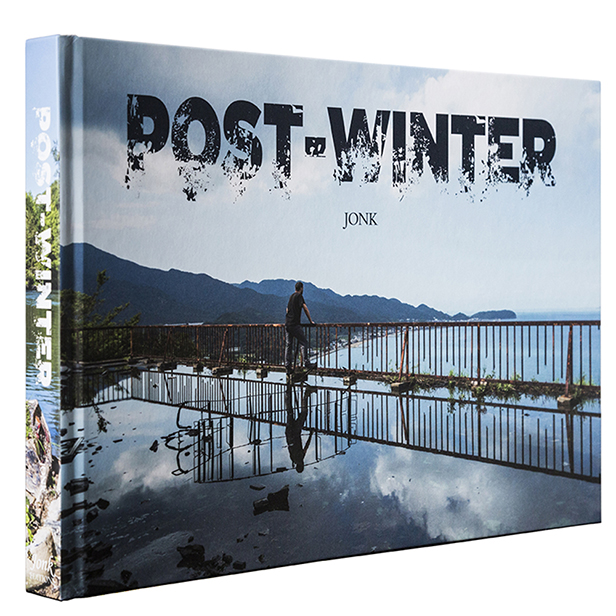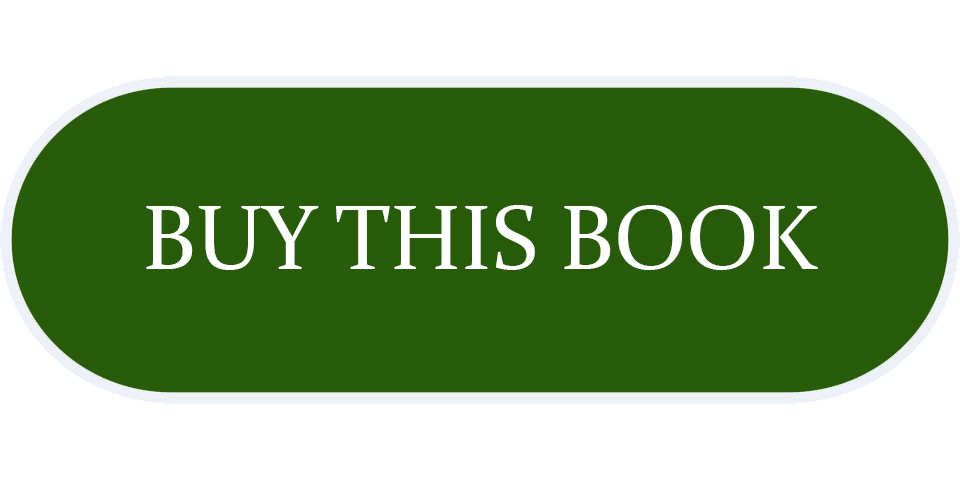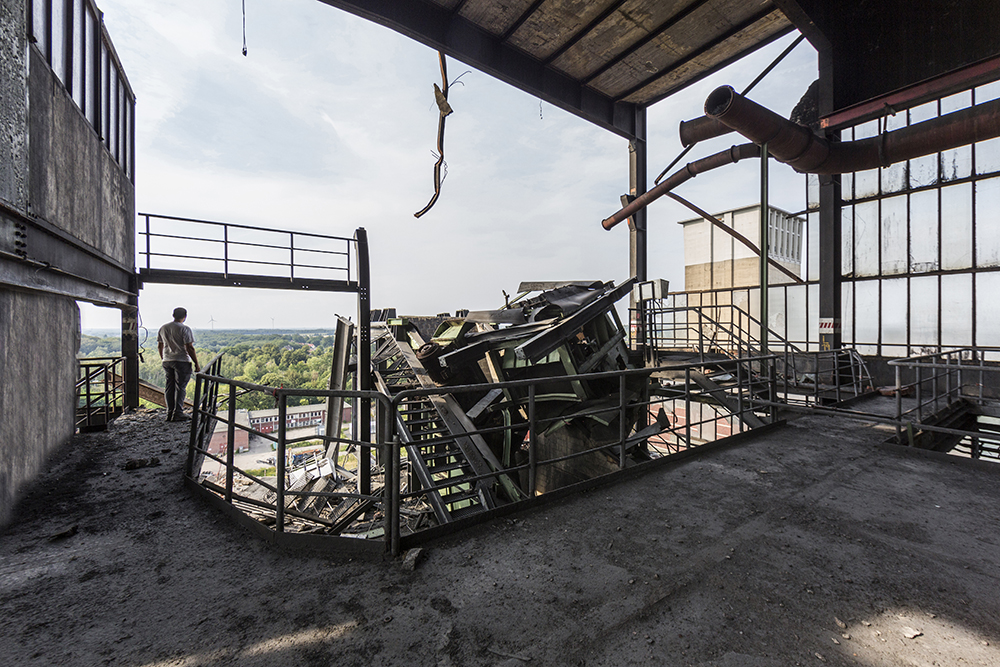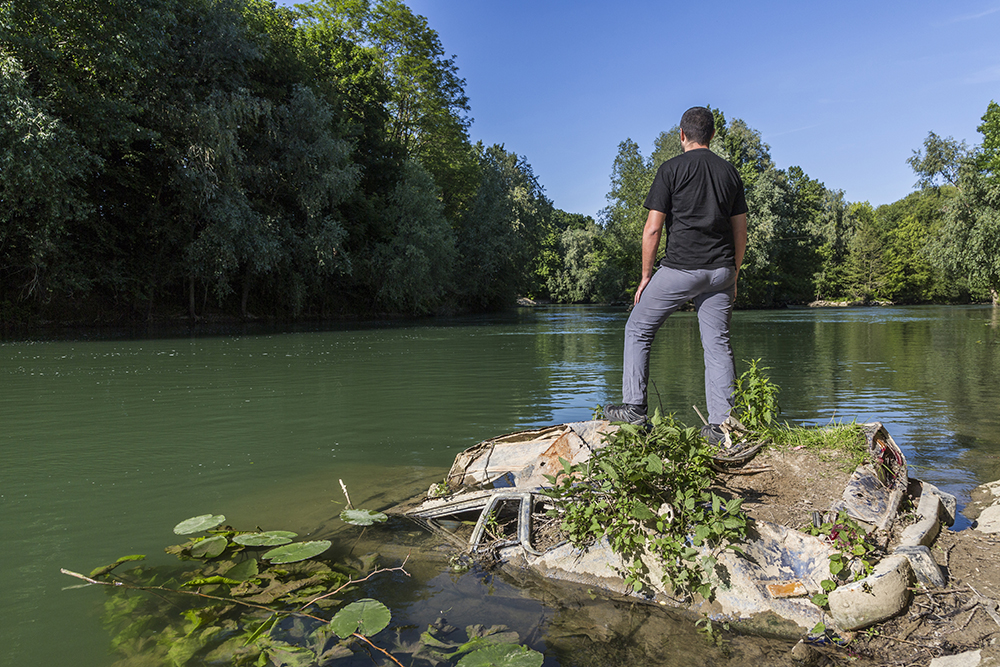
- Hardcover – 224 pages
- Publisher: Jonk Editions
- Language: English (French version: Après l’hiver)
- Format: 30.2cm x 21.6cm
- ISBN: 978-2957645046
Released in april 2022
It all started on a Kiev-Paris flight in the spring of 2017, after my third solo trip to the Chernobyl Exclusion Zone. On the plane, I realize that I want to write a story, that of a man who would have survived a global cataclysm and who would find himself to be the last Man on Earth.
The project matures for a year, the scenario of the story develops in my head and it is in another flight that I put everything black on white. In the Tokyo-Paris that brings me back from three weeks of wastelands in Japan, I fill six pages of notes. Almost everything is there.
Moreover, during this year of maturation, I realize that I could illustrate this story with self-portraits made in abandoned places, perfect settings to represent the world after.
So I start this series around mid-2018.
I haven’t touched the text for over a year. At the end of 2019, I finally settled on this project. My idea is to make about 200 pages including 50 of texts. So I have to develop my six pages of scenarios into fifty pages of narrative. As writing is not my strong point, I propose this essay to my childhood friend Amélie Gressier who has been working for several months on her first novel. She accepts and, after many back and forth between us, gives me a magnificent text of 41 pages, faithful to my basic scenario and very well written. We talk a lot about “lock down babies” and this book is one of them. Indeed, the first lock down made it possible to move forward very quickly on the draft.
In parallel with the creation of the text, I take photos until my last trip before the assembly of the model in September 2021.
For this project, I therefore stepped out of my comfort zone. This is my eighth book and will be the first that is not centered around photos. It could be called an illustrated post-apocalyptic novel but it clearly doesn’t fit into any box. This book is a first of its kind and I’m very proud of the result.
Here is the text from the back cover:
2026, somewhere near Paris. A worldwide conflict and the ensuing nuclear winter will soon lead to the end of life on Earth. Caught off guard, a scientist specialised in cryogenics decides to be the first human guinea pig for his own experiments and sets his alarm to wake him up ten years later. When he opens his eyes again, the world has changed in many respects but above all, he is now alone. And so, he heads off on a long journey to visit some towns he held dear and try to reach Japan, the place he had always dreamt of going in his past life.
Will he make it? How will he survive? And get around? But above all, is he really alone?
With the help of Amélie Gressier who transformed ideas into words, the photographer Jonk, takes us along on this suspenseful adventure full of surprises…
PRESS REVIEW
“Jonk invites us on a long, solitary trip. Gressier’s text is well written, interesting in its description of a man given up to solitude but not desperate, who takes the time to discover what surrounds him and to let himself be carried away by his desires without asking questions. The words take up about a quarter of the book, the rest obviously being taken up by the photographer’s photos, all full page, which illustrate and respond to the text. With a surprising bias: they are always self-portraits. Namely that Jonk photographs himself in many places that he discovers as the protagonist of the story, places that are by turns evocative, captivating, terrible (in what they say about man and his propensity to leave the abandonment of places once teeming with life), beautiful (seeing nature intertwined with metal is often a source of wonder) and also disturbing. With this omnipresence of his silhouette, often taken from behind or in three-quarter view, one could believe in navel-gazing, but it is not so, Jonk rather poses as an observer of what these landscapes tell about the human being, of his history and his renunciation. And, ultimately, its place on the planet. Central of course, as it is so significant because it is at the center of everything and every point of view; but minimal, ultimately, because whatever nature does will end up taking its revenge. Jonk’s photos are a very beautiful illustration of this, managing to freeze all of this in scenographies mixing all materials, greenery, mineral, metallic, plastic… and human. » nooSFere (translated from French)
READERS’ OPINION
“To those who read this review: buy Post-Winter !!!! I suspected the pictures would be beautiful…the scenario was enticing…but I didn’t expect it to be so well written and that the subject, which could have been just another banal SF, would be treated with such finesse, nostalgia, intelligence and humor. Thank you Jonk for this beautiful book.” Catherine, Facebook (translated from French)
“Just to tell you that your book is top notch, with a good story, beautiful photos…especially of Japan which I miss a lot. It’s a nice change from the usual urbex books. Top.” Mathieu, Instagram (translated from French)
“Thank you! We’ll find him a place between Isaac Asimov and Philip K Dick, which by my standards is class!” Thomas, Instagram (translated from French)
“Super it’s exactly what I expected! The photos are incredible and very varied. I loved the text and the thought behind the consequences of loneliness and the various effects of the absence of animal life. When will there be a sequel?” Magali, Facebook (translated from French)
“Very well written, very gripping, and the dose of suspense is well enhanced by the magnificent photos. We’re immersed in this apocalyptic atmosphere. The work is remarkable, bravo !” Xavier, Instagram (translated from French)
“Thank you for this magnificent work, which resonates in these troubled times. I loved it and am now sharing your work with my friends and family.” Philippe, Instagram (translated from French)
“I recommend… The photos are obviously very beautiful, the story is interesting and treated in an original way without bluster but with a lot of lucidity and nostalgia…and on top of that it’s well written.” Catherine, Facebook (translated from French)
“Congratulations on this spectacular work. It’s brilliant, innovative to marry text to images with your character as a witness. Frankly, I’m blown away by your literary talent and your creative vision of fiction.” Pierre, Facebook (translated from French)
“Superb book and the character’s inner journey is very gripping!” Elisabeth, Facebook (translated from French)
“I love the photos as much as the novel. Bravo!” Alain, Facebook (translated from French)
“The texts accompanying the photos are very well done, in a limpid, effective style, with little poetic touches that make them breathe. Bravo for the quality and originality of this work!” Morgan, Facebook (translated from French)


























